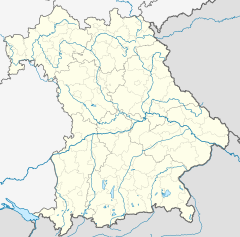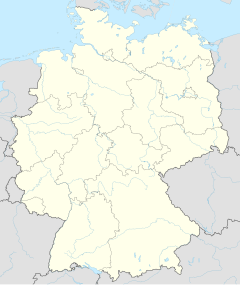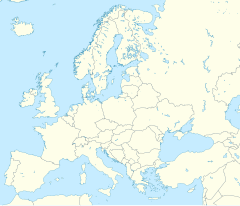Bayerisch Eisenstein railway station
 Bayerisch Eisenstein / Železná Ruda-Alžbětín station in June 2012 | |||||||||||||||||||||||||||||
| General information | |||||||||||||||||||||||||||||
| Location | Czech Republic border with Germany | ||||||||||||||||||||||||||||
| Coordinates | 49°7′18″N 13°12′32″E / 49.12167°N 13.20889°E | ||||||||||||||||||||||||||||
| Elevation | 722 metres (2,369 ft) | ||||||||||||||||||||||||||||
| Owned by | Deutsche Bahn/Správa železnic | ||||||||||||||||||||||||||||
| Operated by | |||||||||||||||||||||||||||||
| Line(s) | |||||||||||||||||||||||||||||
| Platforms | 3 | ||||||||||||||||||||||||||||
| Other information | |||||||||||||||||||||||||||||
| Website | www.bahnhof.de | ||||||||||||||||||||||||||||
| History | |||||||||||||||||||||||||||||
| Opened | 20 October 1877 | ||||||||||||||||||||||||||||
| Services | |||||||||||||||||||||||||||||
| |||||||||||||||||||||||||||||
 | |||||||||||||||||||||||||||||
| |||||||||||||||||||||||||||||
Bayerisch Eisenstein/Železná Ruda-Alžbětín station (German: Bahnhof Bayerisch Eisenstein, Czech: Nádraží Železná Ruda-Alžbětín) is a railway station on the border of southeast Germany and the Czech Republic. It forms the junction between the Bavarian Forest railway from Plattling to Bayerisch Eisenstein, which was started in 1874 by the Bavarian Eastern Railway Company (or Bavarian Ostbahn) and completed by the Royal Bavarian State Railways, and the Pilsen–Markt Eisenstein (today: Plzeň-Železná Ruda) railway built by the Pilsen–Priesen(–Komotau) railway in what was then Bohemia. The national border between Germany and the Czech Republic runs through the middle of the station building.
Construction
[edit]The basis for this railway junction was the Bavarian-Austrian state treaty of 21 June 1851. On the Bohemian side, the Pilsen–Priesen(–Komotau) railway company built the missing section from Neuern to Eisenstein station and opened it on 20 October 1877. On the German side, after the Bavarian Ostbahn was nationalised on 10 May 1875, the line was completed by the Royal Bavarian State Railways and the last section from Ludwigsthal to Eisenstein was opened to railway traffic on 15 November 1877.
Not until just before the completion of the railway lines, did the two railway administrations agree, on 17 May 1877, details of the very large station building and extensive track system needed for the transfer of goods and passengers. This required the local terrain to be filled with over 250,000 m³ of earth and levelled off. The station building was built with its centre section exactly on the border. On either side was an adjoining wing belonging to the respective railway company. The waiting room was designed in a way that was very representative of the style of that era. In the first class waiting room is the largest surviving planked ceiling of its type - a so-called "Cologne ceiling" (Kölner Decke). The station was completed in 1878. On its southern side, west of the track network, that had 9 tracks to begin with and later 11, is the roundhouse with its turntable. Today it houses the Bavarian Localbahn (=branch line) Museum in which the Bavarian Localbahn Society stables more than 20 vehicles from the Lokalbahn era.
The railway line was conceived as the shortest link between Prague and Munich, but because of the steep inclines and tight curves, especially on the Bohemian side, it never attained its intended importance. There was no cross-border traffic until 2006, even after the forced annexation of the Sudetenland into the German Reich in 1938. Only around the turn of the 20th century, in 1900, did through coaches run along the route for a few years from Munich to Prague. Through goods traffic restricted itself to the region.
Iron Curtain
[edit]After the end of the Second World War cross-border traffic came to a complete standstill. In 1953 a wire fence was erected across the station yard by Czechoslovakia and the tracks were severed. Even in the station building itself the border was blocked by walls. Czech passenger services now terminated several kilometres to the north of the border at Železná Ruda (Markt Eisenstein) station. The Deutsche Bundesbahn (DB) ran its trains up to the buffer stop by the border fence and used the southern half of the divided station building. DB steam services to Bayerisch Eisenstein ended for both passenger and goods traffic in the 1970s. For a long time thereafter, railbuses were used; these were later replaced by diesel locomotives hauling silver Silberling coaches.
Reconnection
[edit]
The border crossing was opened again for rail traffic on 2 June 1991. Since then it has been possible to change for České dráhy (ČD) trains to Klatovy and Plzeň after a short wait. Shunters can use the tracks belonging to both railway administrations without worrying about crossing the border. Today on the German side the Regentalbahn runs trains under contract from DB Regio Bayern using the logo Waldbahn (Forest Railway) from Plattling via Regen and Zwiesel to Bayerisch Eisenstein. Once the signal installations of the station were prepared for cross-border services on 28 May 2006 Waldbahn Regio-Shuttles started running as far as Špičák (Spitzberg), 7 km away, where connections to Pilsen are possible. This was the first timetabled cross-border service on this line since it was built in 1877. The Bayerwald-Ticket (Bavarian Forest ticket) fare was extended to cover journeys to Špičák.
In December 2006 the former name of the Czech part of the station, Železná Ruda, was officially changed to Železná Ruda-Alžbětín.
In the 2007/08 annual timetable, trains ran hourly from Plattling to Bayerisch Eisenstein and some continued as far as Špičák. On the Czech side, local trains run to Klatovy and expresses to Pilsen, some going on to Prague.
These cross border passenger trains have since ceased operation. The summer 2021 timetables show German and Czech trains terminating at the station with connections between them
Services
[edit]| Train class | Route | Frequency |
|---|---|---|
| RB 35 | Plattling – Deggendorf – Zwiesel (Bay) – Bayerisch Eisenstein | Hourly |
See also
[edit]References
[edit]External links
[edit]- for Bayerisch Eisenstein border station at the Bavarian State Office for the Preservation of Historic Buildings and Monuments
- Bavarian Localbahn Society (via Archive.org)
- E.U. expansion sparks fireworks, high hopes article (via Newspapers.com) from the Charlotte Observer with a photograph showing a ceremonial steam locomotive hauled train passing Bayerisch Eisenstein station to commemorate the Czech Republic's entry into EU membership.


